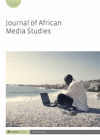
Full text loading...

Via content analysis, this study investigates the visual portrayal of Sierra Leone, Liberia and Guinea in US newspapers during the 2014 Ebola epidemic. Salience of identified frames and tone is assessed relative to findings identified in existing literature. Data were collected from the New York Times, Atlanta Journal-Constitution and Dallas Morning News. Findings suggest coverage did not favour victim-only frames, relative to other types of frames, whose visual tone became marginally less negative once Ebola patients were in the United States. Such results contribute to literature regarding African media studies, public perception of foreign affairs and press coverage of international health epidemics.

Article metrics loading...

Full text loading...
References


Data & Media loading...

Publication Date:
https://doi.org/10.1386/jams_00086_1 Published content will be available immediately after check-out or when it is released in case of a pre-order. Please make sure to be logged in to see all available purchase options.